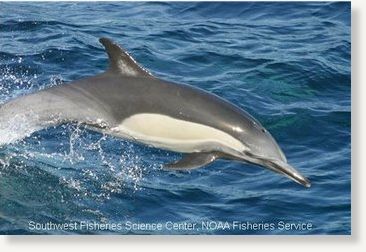
© National Marine Fisheries Service
Navy training off the Silver Strand has been linked to the deaths of at least three dolphins in the area and may be responsible for two more, the
National Marine Fisheries Service said on Friday.
Fisheries agency leaders said they will take another look at the Navy's pending request to
disturb marine mammals between
Imperial Beach and Coronado, where the Navy runs what it calls "a realistic venue for amphibious training and special warfare tactical training in the coastal environment." The existing application - which has been in the works for years - doesn't anticipate dolphin deaths related to training, and that premise is now in question.
The fisheries service also has opened an enforcement case. A central question is whether the Navy violated the Marine Mammal Protection Act of 1972, a landmark law designed by Congress to safeguard dolphins, whales and similar creatures.
Environmentalists, who have long been concerned about damage by Navy sonar on marine mammals, have called on the Navy to suspend activities involved in the deaths and to conduct a transparent investigation into the incident. Ocean advocates and fisheries experts could not recall a similar incident in Southern California.
Navy officials said they were doing everything by the book on the morning of March 4, when crews detonated an explosive off the Silver Strand. Cmdr.
Greg Hicks, a spokesman for the Third Fleet, said an investigation is underway that should take about a month and that will determine what changes, if any, the Navy makes to its "mission-critical" practice.
Hicks said the Navy is continuing its training program in the area.
"We have an excellent track record in our training and have exacting standards that we apply to try to prevent these types of incidents," Hicks said. "We do our best to protect marine life while conducting essential training."
He said he could not quantify the number of underwater blasts that the Navy has performed at the site in recent years. Documents show the Navy's permit request for underwater explosives involve up to 415 "small" detonations during 311 training events a year.Hicks said the Navy has been developing its application for years and continued training during the sign-off process with the "approval and knowledge" of regulators.
"Injuries are unlikely given low impulse pressures and short radii for the impact zones during training," the permit request said.
Underwater explosives are important for clearing obstacles out of harbors so ships can enter. When the Navy practices with them offshore, Hicks said observers look for dolphins, seals, whales and similar creatures that might swim into the danger zone.
On March 4, the training area was between a half-mile and 1 mile from the strand.
"When the countdown to detonation began, no marine mammals were sighted in the area," Hicks said. "
At the last minute before this thing goes, (observers) see something, and we can't put our people at risk to disarm the device."
After the blast, the Navy found three dead long-beaked
common dolphins and reported them to the fisheries service. There are about 15,000 of that species off the California coast, and they aren't considered endangered.
Fisheries service biologist Sarah Wilkin in Long Beach said two other dead dolphins were found later, but it's not clear if they were injured by the Navy exercises.
The first three dolphins underwent necropsies and other analyses, and Wilkin said
preliminary results show injuries consistent with blast trauma.At the
Natural Resources Defense Council, senior policy analyst Michael Jasny said the Navy's history with military exercises off the coast suggests the need for more scrutiny. Years ago, the environmental group sued the Navy to minimize damage to marine mammals by sonar.
"There is training and there is training safely with full safeguards for the protection of the environment," Jasny said. "They haven't always done that."
Jasny said the dolphin deaths show the Navy needs to take more protective measures during training and
apply for a permit that would allow killing marine mammals rather that just harassing them.
Reader Comments
to our Newsletter